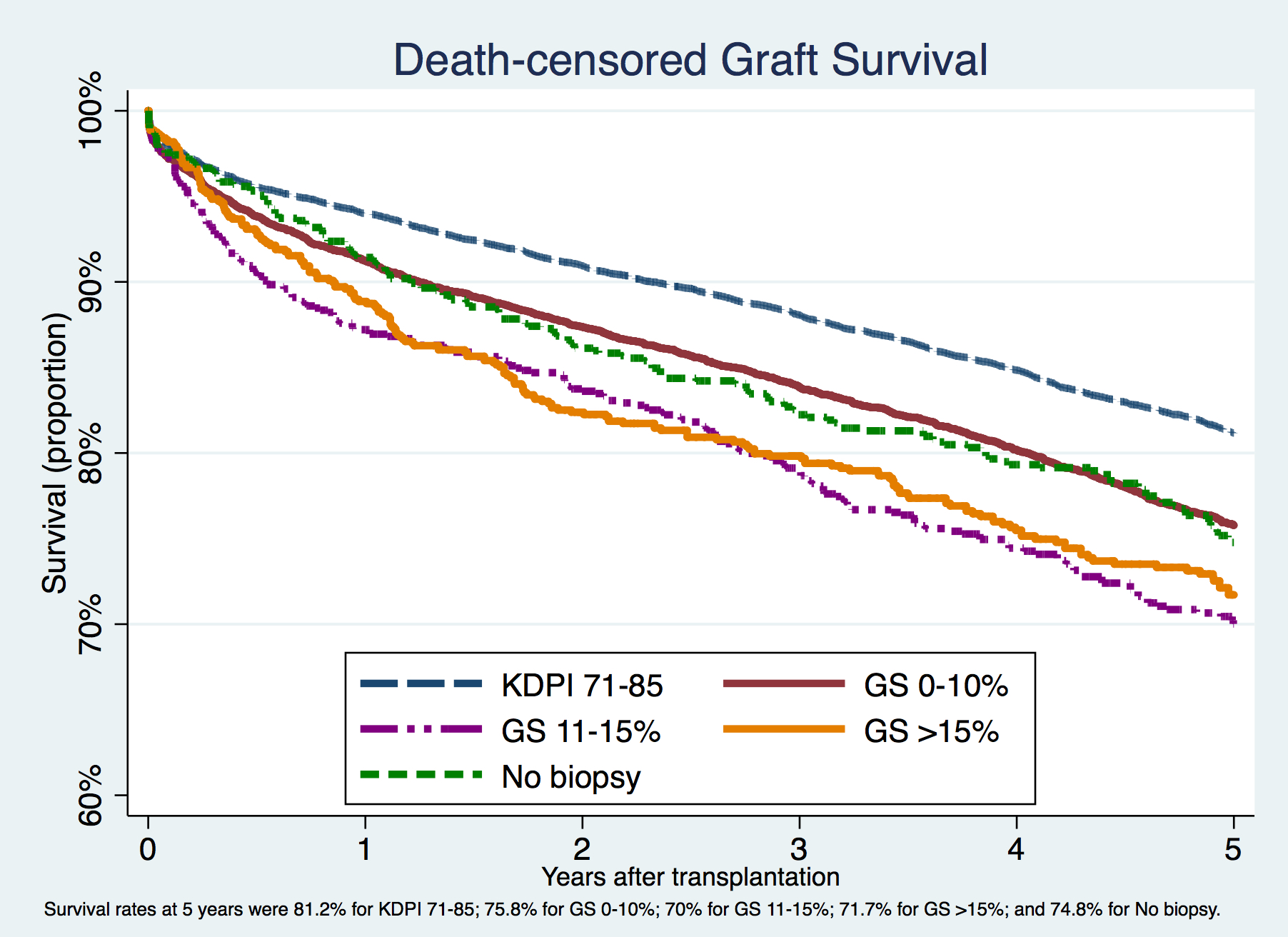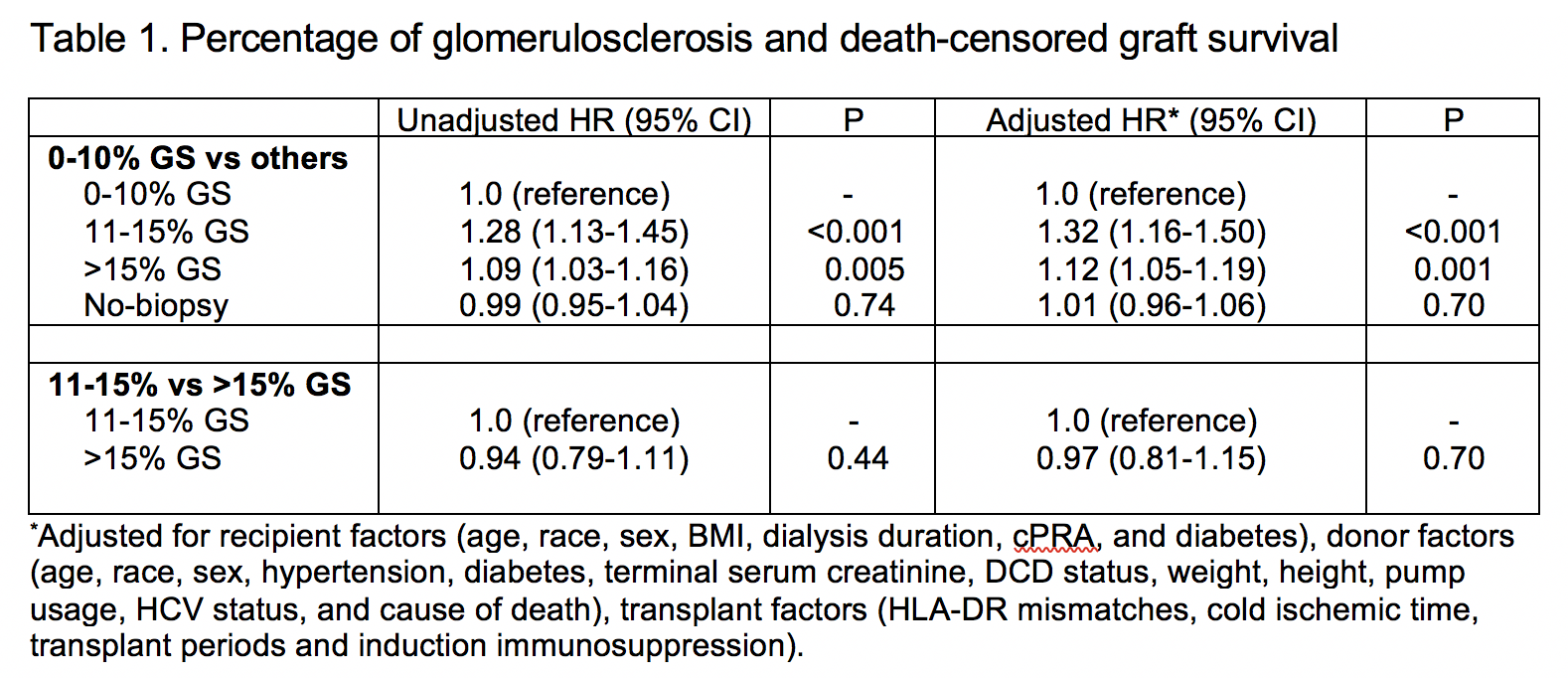The Degree of Glomerulosclerosis in Procurement Renal Biopsy and its Implications in Predicting Graft Outcomes in Marginal Donor Kidneys
1University of Mississippi Medical Center, Jackson, MS, 2Saint Luke's Health System, Kansas City, MO
Meeting: 2019 American Transplant Congress
Abstract number: 218
Keywords: Biopsy, Donors, marginal, Graft survival, Kidney transplantation
Session Information
Session Name: Concurrent Session: Kidney Donor Selection / Management Issues II
Session Type: Concurrent Session
Date: Monday, June 3, 2019
Session Time: 2:30pm-4:00pm
 Presentation Time: 2:30pm-2:42pm
Presentation Time: 2:30pm-2:42pm
Location: Ballroom C
*Purpose: Percentage of glomerulosclerosis (GS) is a major determinant for kidney discard. However, GS failed to consistently predict graft outcomes across studies in the literature. We aimed to investigate this association using UNOS/OPTN database.
*Methods: Deceased donor kidneys with KDPI>85% and donor weight >20 kg recovered between December 31, 2004, and December 2, 2014, were stratified into 4 groups based on the percentage of GS: 0-10%, 11-15%, >15%, and no biopsy performed. The rate of discard was examined. Death-censored graft survival (DCGS) of recipients who received those kidneys were then examined.
*Results: 23,634 kidneys were recovered. 92.4% of recovered kidneys were biopsied. The overall rate of discard was 52.2%. After excluding 1,628 kidneys used for dual-kidney transplants, the rates of discard based on the percentage of GS were 33.5%, 53.9%, 81.1%, and 49.8%, for 0-10% GS, 11-15% GS, >15% GS, and no biopsy, respectively. After excluding multi-organ transplants and recipients with prior transplants, there were 10,312 recipients (75.6% with 0-10% GS, 8.2% with 11-15% GS, 8.6% with >15% GS, and 7.6% with no biopsy). Kidneys that were not biopsied were likely coming from deceased donors with younger age, no underlying diabetes or hypertension, and were less likely to be ECD kidneys (by pre-KAS criteria). Five-year DCGS was shown in Figure 1. Using 0-10% GS as a reference group, recipients with 11-15% GS (HR=1.32, P<0.001) and >15% GS (HR=1.12, P=0.001) had an increased risk of graft failure. No differences in DCGS between 0-10% GS versus no-biopsy, and 11-15% GS versus >15% GS (see Table 1).
*Conclusions: The rate of discard increases progressively with increasing degrees of glomerulosclerosis. Donor kidneys with GS>10% is an independent risk factor for graft failure. Although statistically significant, the margins of differences are minimal. The clinical interpretation of this study is limited by the lack of data on other histologic parameters which may improve the predictive value of procurement biopsies.
To cite this abstract in AMA style:
Cheungpasitporn W, Chon W, Island E, Cummings L, Forster J, Leeaphorn N. The Degree of Glomerulosclerosis in Procurement Renal Biopsy and its Implications in Predicting Graft Outcomes in Marginal Donor Kidneys [abstract]. Am J Transplant. 2019; 19 (suppl 3). https://atcmeetingabstracts.com/abstract/the-degree-of-glomerulosclerosis-in-procurement-renal-biopsy-and-its-implications-in-predicting-graft-outcomes-in-marginal-donor-kidneys/. Accessed December 28, 2025.« Back to 2019 American Transplant Congress


